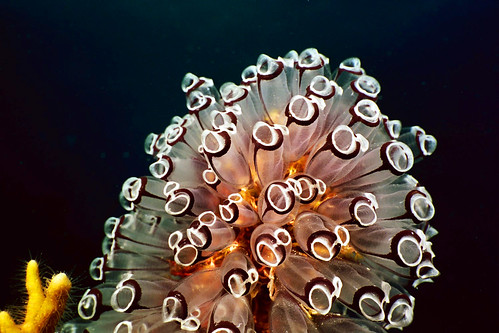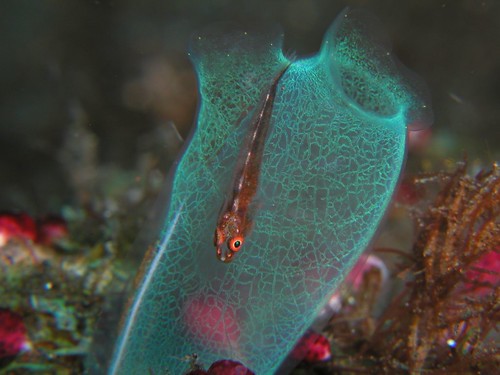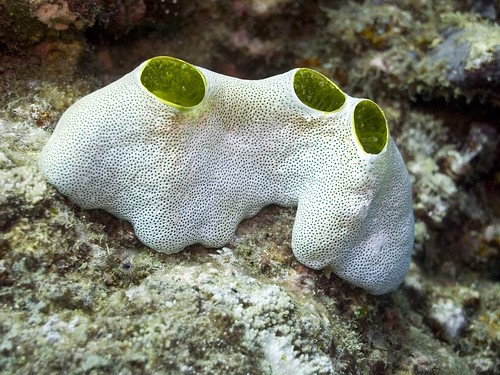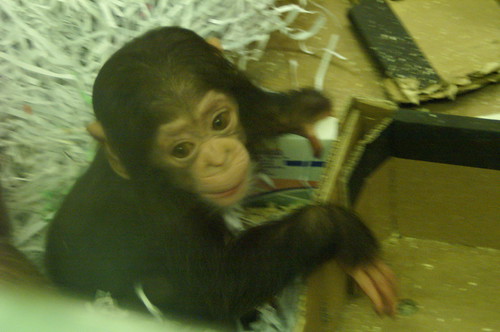Meet the relatives: Sea Squirts
These are astonishingly beautiful animals sometimes confused with jellyfish. They’re not. They are actually our cousins. (Admittedly, jellyfish are also beautiful, and if you go far enough back, they’re also our cousins, but work with me here, okay?)
Since sea squirts are related to us, that means they’re useful as well as beautiful. Useful in medical research, that is. Pictures and fun facts below the fold.

Painted tunicate,
photo: divemasterking

tunicate, with resident goby
photo: Chika

Tunicate
Didemnium molle,
beautiful, but not quite the same movie star quality.
photo: Boogies with Fish
To be exact, only the immature stages have the famous rudimentary “backbone,” the notochord, that makes these things so interesting to us vertebrates. The adults, as happens so often, just sit on their duffs and eat crap.

tunicate larva, nice notochord…
photo: tunicates.com
What this means is that vertebrates evolved after a mutation in tunicates allowed the mutants to stay juvenile their whole lives. In other words, they could reproduce even though in other ways they were still “kids.” That’s a fascinating and recurring theme in evolution. Humans are another example, since we’re basically baby apes.
< tangent>
I’m rather taken with the philosophical implications of all this. I mean, compare the following:

trilobite photo: Kevin Brett |
 squishy, barely visible to the naked eye |

photo: Wikipedia |

photo: Tim Ellis |
To me it suggests that “the meek shall inherit the Earth” is not wishful thinking. It’s just a statement of fact. Maybe we don’t have a very good understanding of what strength really is.
< end tangent>
Anyway. Onward and upward. Medicine. I wasn’t joking when I said the adults sit there and eat crap. They’re filter feeders, like oysters, and are often found in muddy, bacteria-laden waters.
About 80% of their genes are also found in humans and other vertebrates, but the total amount of DNA they have per cell is only about half that of vertebrates. They’re missing a lot of genes that we have, and some of them are the more advanced immune system genes. So you have a mystery. Somehow, a creature with very few immune system tools is staying healthy under conditions that would kill us, even though we’re quite similar (all appearances to the contrary notwithstanding).
Scientists started looking and found all sorts of interesting things. As you might expect from something that eats dirt, tunicates produce weird antibiotics. They’re not only new, but they have a different mode of action, which means that currently resistant bacteria are not resistant to the tunicate antibiotics at all. Unfortunately, some of these compounds are just as good at blowing up red blood cells as bacteria, so they need more work. But because of the way they’re formed (see pdf if you want a bit more of the science), genetic engineering is likely to be able to modify them to keep the good and toss the bad.
Anti-virals, immune suppressants, and anti-cancer compounds have also been found (e.g. Wikipedia, but, like the antibiotics, they’re too effective. They need work to make them less toxic to normal cells. (This isn’t unusual with cancer drugs. The Vinca alkaloids, which ultimately stopped childhood leukemia from being a death sentence, started out the same way.)
And then there’s the fascinating field of regenerative medicine, something which didn’t exist ten years ago. This includes things like re-growing spinal cords or limbs, and growing replacement organs like livers, hearts, skin, or eyes. Because tunicates are rather simplified versions of us, it’s easier to study processes of cell growth and regulation. The result is that a team of Stanford scientists published a paper (abstract just this past May describing how they made an abnormally growing colonial tunicate grow normally again over a period of time. A tumor is nothing but an abnormally growing set of cells, so people are agog about this work. Now that they’ve found this pathway, they can study it in detail and find out exactly how the cells regulate themselves back to normality. Then they can try to modify that so it works in humans. It’ll take a few years….
So next time you happen to be snorkelling or scuba diving in a mangrove swamp, peer through the muddy water until you see bright geometric jewels loom up in front of your face and think about the cloud of invisible possibilities they represent.




can humans eat them or not!!!!!!!!!!
gtrrrr on January 31st, 2009 at 07:52
Yes, they can
Austin on October 30th, 2009 at 06:52
But they wouldn’t be very flavorful. I don’t even want to think about the texture.
quixote on May 21st, 2012 at 07:22